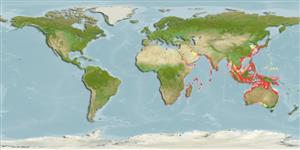Teleostei (teleosts) >
Eupercaria/misc (Various families in series Eupercaria) >
Sparidae (Porgies)
Etymology: Rhabdosargus: Greek, rhabdos = stick + Latin, sargus = sargus (1591) (Ref. 45335).
More on author: Forsskål.
Environment: milieu / climate zone / depth range / distribution range
Ecology
Marine; brackish; reef-associated; oceanodromous (Ref. 51243); depth range 0 - 60 m (Ref. 30573). Tropical; 36°N - 38°S, 19°E - 155°E (Ref. 57004)
Indo-West Pacific: Red Sea and East Africa to Japan, China, and Australia.
Length at first maturity / Size / Weight / Age
Maturity: Lm 23.7 range ? - ? cm
Max length : 80.0 cm TL male/unsexed; (Ref. 3678); common length : 45.0 cm TL male/unsexed; (Ref. 1724); max. published weight: 12.0 kg (Ref. 1724)
Inhabit coastal waters (Ref. 30573, 44894), usually entering estuaries (Ref. 44894). Abundant in shallow water and often caught at the surf-line or in rock pools (Ref. 9987). Larger, solitary fish sometimes enter brackish mangrove areas (Ref. 9987). Juveniles in estuaries move into deeper water with growth (Ref. 4335). Often in schools (Ref. 9710). Feed on benthic invertebrates, mainly mollusks (Ref. 5213) and aquatic macrophytes (Ref. 26055). Popular angling species commonly captured with hook and line (Ref. 44894). Marketed fresh (Ref. 5284).
Normally sexes are separate but some individuals are protandrous due to geographical variation in sexual pattern (Ref. 103751). Gonochorism is confirmed in Australia, and protandry in Asia (Ref. 103751). Also Ref. 28504.
Bauchot, M.-L. and M.M. Smith, 1984. Sparidae. In W. Fischer and G. Bianchi (eds.) FAO species identification sheets for fishery purposes. Western Indian Ocean (Fishing Area 51). volume 4. [var. pag.] FAO, Rome. (Ref. 3507)
IUCN Red List Status (Ref. 130435)
Threat to humans
Harmless
Human uses
Fisheries: commercial; aquaculture: commercial; gamefish: yes
Tools
Can't connect to MySQL database fbquizv2. Errorcode: Too many connections
